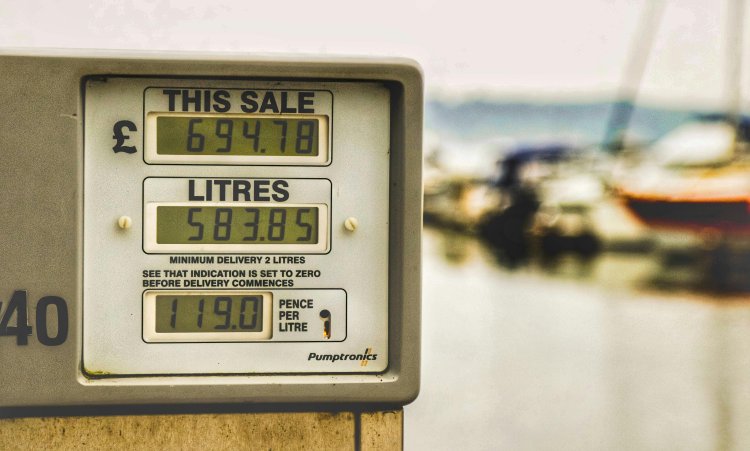How to increase the fuel efficiency of your car with performance upgrades
How to increase the fuel efficiency of your car with performance upgrades. Read to find out more!
Share this Post to earn Money ( Upto ₹100 per 1000 Views )

When buying a car, some of the most important things to check are its performance and fuel efficiency, even if the car has been fitted with aftermarket performance upgrades. Fuel efficiency is crucial for a car because:
· Cost Savings: Higher fuel efficiency means a car can travel more miles on a gallon of fuel, reducing the overall cost of fuel for the driver. This is particularly important as fuel prices fluctuate.
· Environmental Impact: Cars with better fuel efficiency consume less fuel, which in turn reduces greenhouse gas emissions and other pollutants. This helps to mitigate environmental issues such as global warming and air pollution.
· Energy Conservation: Fuel-efficient cars use less energy, helping to conserve finite natural resources like oil. This is important for reducing dependency on fossil fuels and promoting energy sustainability.
· Increased Vehicle Range: A fuel-efficient car can travel longer distances on a single tank of fuel, which is beneficial for long trips and reduces the need for frequent refuelling.
· Regulatory Compliance: Many countries have fuel efficiency standards that car manufacturers must meet. Vehicles with higher fuel efficiency are more likely to comply with these regulations, avoiding penalties and promoting the development of greener technologies.
· Resale Value: Fuel-efficient cars often have a higher resale value, as they are more attractive to buyers looking to save on fuel costs in the long term.
Fuel efficiency is key to reducing operating costs, minimising environmental impact, and enhancing energy sustainability.
How to increase the fuel efficiency of your car with performance upgrades
Increasing the fuel efficiency of your car through performance upgrades involves making changes that reduce fuel consumption while maintaining or even improving the vehicle's overall performance. Here are some key strategies:
1. Upgrade the Air Intake System
· Cold Air Intakes: Installing a cold air intake allows cooler, denser air to enter the engine, which can improve combustion efficiency and boost power, potentially reducing fuel consumption.
· High-Flow Air Filters: Replacing the stock air filter with a high-flow version can improve airflow to the engine, increasing efficiency and performance.
2. Install a Performance Exhaust System
· Free-Flow Exhaust: A less restrictive exhaust system can reduce backpressure, allowing the engine to expel exhaust gases more efficiently. This can improve engine performance and fuel efficiency.
· Headers: Upgrading to performance headers can also help the engine breathe better, leading to better fuel economy.
3. Use a Performance Chip or Tuner
· ECU Tuning: A performance chip or tuning device can adjust the engine control unit (ECU) to optimise fuel injection, ignition timing, and other parameters for better fuel efficiency. Some tuners are specifically designed to improve fuel economy.
4. Switch to Synthetic Fluids
· Engine Oil: Using high-quality synthetic motor oil can reduce engine friction, which can improve fuel efficiency.
· Transmission Fluid and Differential Oil: Synthetic fluids can also reduce friction in the transmission and differential, contributing to better fuel economy.
5. Upgrade the Spark Plugs
· High-Performance Spark Plugs: Installing high-quality spark plugs can improve the efficiency of the combustion process, leading to better fuel economy.
6. Optimise Tyre Performance
· Low Rolling Resistance Tires: Switching to tires designed for low rolling resistance can reduce the amount of energy needed to move the car, thereby improving fuel efficiency.
· Proper Tyre Inflation: Keeping tyres properly inflated is a simple but effective way to maximise fuel efficiency.
7. Lighten the Vehicle
· Weight Reduction: Removing unnecessary weight from the car, such as non-essential items or swapping out heavy parts for lighter ones, can reduce the amount of energy required to move the vehicle, improving fuel efficiency.
8. Aerodynamic Enhancements
· Body Kits: Adding aerodynamic body kits or spoilers can reduce drag, making the car more efficient at highway speeds.
· Lowering the Vehicle: Reducing the car’s ride height can improve aerodynamics by reducing air resistance.
9. Upgrade the Fuel System
· Fuel Injectors: Installing more efficient fuel injectors can improve the fuel atomisation process, leading to better combustion and improved fuel economy.
· Fuel Pressure Regulator: An adjustable fuel pressure regulator can help optimise the fuel delivery for better efficiency.
10. Improved Cooling Systems
· Performance Radiators: Upgrading to a performance radiator can keep the engine running at optimal temperatures, improving efficiency.
· Thermostats and Fans: High-performance thermostats and electric fans can also help maintain optimal engine temperatures, aiding fuel efficiency.
11. Use High-Quality Fuel
· Premium Fuels: Using premium fuel that contains detergents and higher-octane levels can improve engine performance and fuel efficiency, especially in engines designed for it.
12. Advanced Drivetrain Components
· Performance Transmissions: Upgrading to a more efficient transmission or using a transmission controller to optimise gear shifts can lead to better fuel efficiency.
· Lightweight Drivetrain Components: Replacing heavy components like driveshafts with lightweight materials can reduce energy loss and improve efficiency.
While these upgrades can improve fuel efficiency, it is important to balance them with cost considerations and ensure they are appropriate for your specific vehicle. Additionally, regular maintenance, such as keeping the engine tuned and replacing worn-out parts, is essential for maintaining fuel efficiency.
How to choose the right performance upgrades for your car’s fuel efficiency
Choosing the right performance upgrades for improving your car’s fuel efficiency requires careful consideration of your vehicle’s specific needs, your budget, and the type of driving you typically do. Whether you are thinking of adding turbo accessories to your car like blow off valves, or a performance air intake, here is a guide to help you make the best choices:
1. Assess Your Vehicle’s Current Condition
· Engine Health: Ensure your engine is in good working condition before considering upgrades. If there are underlying issues like poor compression or worn-out parts, address those first.
· Fuel System: Check for any existing issues with the fuel system, such as clogged injectors or a dirty fuel filter, which might negate the benefits of performance upgrades.
2. Set Clear Goals
· Fuel Efficiency vs. Performance: Determine if your primary goal is to improve fuel efficiency, increase performance, or a balance of both. Some upgrades may boost power but slightly reduce fuel efficiency, while others can enhance both.
· Budget Considerations: Consider how much you are willing to spend. Some upgrades, like performance chips or cold air intakes, are relatively affordable, while others, like advanced ECU tuning or high-end exhaust systems, can be more expensive.
3. Understand Your Driving Habits
· City vs. Highway Driving: If you mainly drive in the city, upgrades that improve low-end torque and reduce fuel consumption during stop-and-go traffic are beneficial. For highway driving, focus on aerodynamics and efficiency at higher speeds.
· Daily Use vs. Occasional Performance: Consider whether your car is a daily driver or if you use it for occasional spirited driving. Daily drivers benefit more from upgrades that enhance reliability and long-term fuel efficiency.
4. Research Compatible Upgrades
· Manufacturer Recommendations: Check if the car manufacturer recommends any specific upgrades or if there are known successful modifications for your car model.
· Aftermarket Reviews: Look at user reviews and expert opinions on aftermarket parts. Products with a proven track record of enhancing fuel efficiency are usually a safer bet.
· Warranty Impact: Some upgrades might void your car’s warranty. Consider whether you are willing to risk that, or look for parts that maintain warranty compliance.
5. Prioritise Upgrades with the Best ROI
· High ROI Upgrades: Start with upgrades that offer the most significant improvement in fuel efficiency for the lowest cost. Cold air intakes, high-flow air filters, and performance spark plugs often provide good returns.
· Long-Term Benefits: Consider the long-term savings in fuel costs compared to the initial investment. Upgrades that save you money over time, like synthetic fluids and low rolling resistance tires, are usually worthwhile.
6. Consult with Professionals
· Mechanic or Tuner: If you are unsure about which upgrades are right for your car, consult a mechanic or a performance tuner who specialises in your vehicle type. They can recommend upgrades based on your goals and vehicle condition.
· Custom Tuning: For more advanced upgrades like ECU tuning, it is often best to have a professional perform the modifications to ensure optimal performance and fuel efficiency.
7. Consider Compatibility and Integration
· System Compatibility: Ensure that any upgrades you choose are compatible with each other. For example, if you upgrade the air intake, you might also need to upgrade the exhaust system to see the full benefits.
· Vehicle-Specific Mods: Some cars have aftermarket communities that have already tested and optimised specific upgrades. Leveraging this knowledge can help you choose the most effective modifications for your specific make and model.
8. Evaluate the Impact on Other Systems
· Balance of Power and Efficiency: Some upgrades might increase power at the cost of fuel efficiency. It is important to understand how each part interacts with the overall system.
· Drivability and Comfort: Consider how the upgrades will affect the drivability and comfort of your car. Some performance parts might make the car more powerful but could compromise comfort or increase maintenance needs.
9. Plan for Future Upgrades
· Modular Upgrades: If you plan to make multiple upgrades, consider a phased approach where each modification complements the next. This ensures that you do not need to undo previous work as you continue improving your vehicle.
· Scalability: Choose upgrades that allow for future improvements. For example, a performance exhaust system that can later be paired with a turbocharger or supercharger.
10. Test and Monitor Performance
· Track Fuel Efficiency: After making upgrades, monitor your fuel efficiency to ensure the modifications are delivering the expected results. Use a fuel efficiency tracking app or manually calculate it over several fill-ups.
· Adjustments: If you are not seeing the desired improvements, you might need to fine-tune the upgrades or consider additional modifications to balance out the system.
Carefully selecting and integrating the right performance upgrades, you can effectively increase your car’s fuel efficiency while also potentially enhancing its overall performance.















